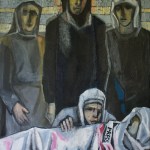
Published by Yehoshua Sobol — the well-known Hebrew playwright, whom we recently came to know through Al-Ittihad newspaper for his socially themed play “Kriza.”
This article appeared in the newspaper “Al Hamishmar” on 11 April 1977, and we are publishing it here in full.
In the nineteenth century, they would have begun a case like this by saying:
“An evil spirit haunts the corridors of the temple in a terrifying form: the art consultant of the Haifa Municipality is suspected—without malice!—of having given technical guidance to an Arab young man who wished to build a memorial in memory of the martyrs of Land Day.”
But since we live in the twentieth century—though sometimes it’s hard to believe that, given the facts on the ground—let us try to tell the story simply.
Abed Abdi is an artist, painter, and sculptor from Haifa, born there to a family that settled in the city three generations ago. In his early steps as a painter in the early 1960s, his works caught the attention of Gershon Knispel, who encouraged the young artist to develop his talent. Thus, in 1964, Abdi joined the Painters’ Association, becoming the first Arab member, and served actively on its committee.
Later, Abdi traveled to East Germany to continue his studies in mural painting and graphic art, spending seven years there. After completing his studies, he returned to the country five years ago. In 1974, he received the Hermann Struck Award. Over the years, his acquaintance with Knispel developed into a friendship between two artists whose creative fields were closely related.
As the first anniversary of the six martyrs of Land Day approached, Abdi decided to design a memorial monument in their honor. His first idea was to depict a woman holding a dead dove in her hands. About six weeks ago, Abdi presented the idea to Knispel. Together they discussed the concept and concluded that it was too general, too symbolic, and not closely connected to the essence of what the monument should express: the bond between the Arab farmers and their land—a daily, simple relationship that has existed for hundreds of years of cultivation, without symbols of violence or hatred toward anyone.
Thus, through their discussions, a new concept took shape:
The base of the monument—a square form—would depict figures bending over the land while performing various farming tasks, and above them would rise a traditional Arab wooden plow, the tool that had tilled the soil for centuries.
Once the idea took shape, Abdi began building a model of the monument to present as a proposal to the local council of Arraba, where it was meant to be placed at the village entrance.
At this point, the news reached the press, and a report appeared in The Jerusalem Post under the headline:
“Consultant Knispel ‘cleared’ of aiding the artist of the Land Day memorial.”
The article recounted an “investigation” conducted at Haifa Municipality, concluding that Knispel had been “cleared,” since the assistance and advice he gave Abdi were “on a personal basis.”
Knispel responded to the commotion with a smile of surprise, saying:
“Yes, the collaboration with Abed Abdi was done on my personal time, as an independent artist, not within my position as an art consultant for the Haifa Municipality. But I see no reason to apologize to anyone.
On the contrary, I am proud of my cooperation and joint work with Abdi, and I need no ‘clearance’ from anyone regarding my collaboration with an Arab artist who is also my personal friend.”
We heard similar words from Abed Abdi, who said:
“I am proud that in this case, there was cooperation between a Jewish and an Arab artist. The monument contains no element that might incite hatred toward the other people. It is built on the idea of the bond between the human being who cultivates the land and his land itself, from a positive perspective.
It is a monument that does not raise its fist in defiance—and if we have raised anything, it is a plow.
Whoever believes the plow is a negative symbol may come and destroy the plows.”
At present, it is said that within the Haifa Municipal Council, there are some who seem to believe that the plow is, in fact, a negative symbol. These members are expected to request that the issue be brought before the City Council for further discussion.
Translated from Arabic. Source: Al Ittihad newspaper




















